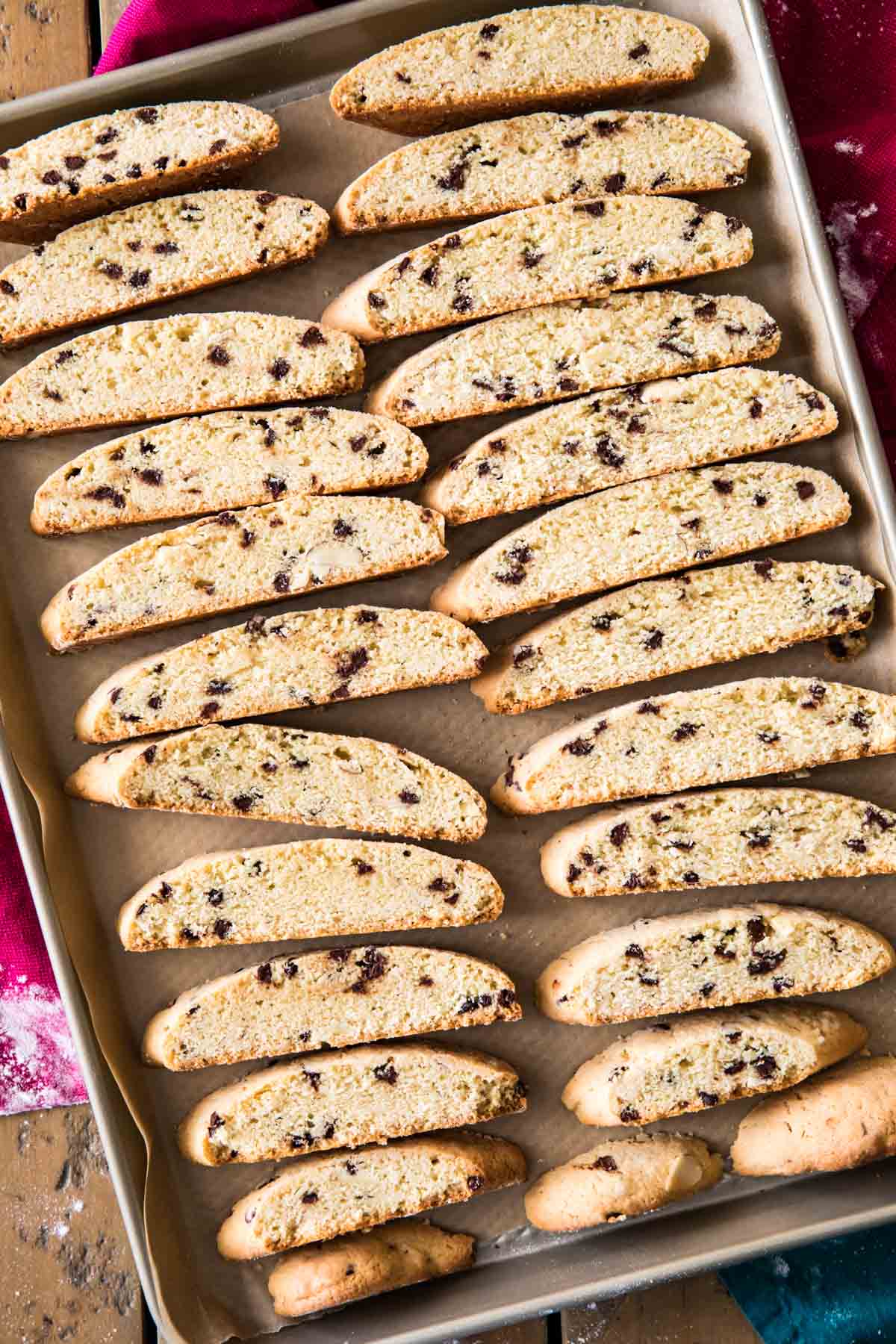If you’re looking to start your day the Italian way, you’re in for a treat. Breakfast in Italy is more than just a meal; it’s a delightful experience steeped in tradition. These breakfasts are simple yet delicious, often featuring fresh ingredients that highlight the country’s rich culinary heritage.
What are some of the most beloved Italian breakfast foods that locals enjoy? From sweet pastries to savory bread and cheese, Italian breakfasts offer a variety of flavors to suit every palate. Whether you’re planning a trip to Italy or just want to bring a touch of Italian culture into your morning routine, exploring these breakfast options can be a fun and tasty adventure.

1) Cappuccino
Cappuccino is a classic Italian breakfast beverage. It consists of a shot of espresso, steamed milk, and a thick layer of foamed milk on top. Italians often enjoy it first thing in the morning and rarely after 11 a.m.
You can find cappuccino in nearly every café and home in Italy. It’s known for its rich, creamy texture, which makes it incredibly satisfying on its own. Many Italians prefer not to pair it with other foods.
Preparing a good cappuccino requires practice. The milk must be steamed to the right temperature and foamed to just the right consistency. The espresso should be strong and aromatic. Each component plays a crucial role in creating the perfect cup.

2) Cornetto
Cornetto is a staple of Italian breakfast. It looks like a croissant but differs in texture and taste. Often sweet, it’s a perfect companion to your morning coffee. Sometimes called an Italian croissant, cornetto has a slightly thicker and less flaky texture.
You may find cornetti filled with various ingredients. From jams to custards or even Nutella, there’s a variety of flavors to enjoy. Some prefer it plain, with just a dusting of powdered sugar on top.
The dough is made with flour, sugar, eggs, butter, and yeast. It’s then shaped into a crescent before being baked till golden brown. The result is a delicious pastry that’s soft inside and slightly crisp on the outside.
Historically, the cornetto has roots in the Viennese kipfel. This dessert arrived in Italy in the 17th century due to trade between Venice and Vienna. Over time, Venetian pastry chefs adapted it, giving birth to the cornetto you enjoy today.
Pairing a cornetto with a cappuccino is a classic Italian morning routine. It provides a light and sweet start to the day. So, when in Italy, make sure to try this delightful pastry for breakfast.

3) Frittata
A frittata is an easy and delicious Italian breakfast dish. It’s similar to an omelet but cooked more slowly and often finished in the oven.
To make a frittata, you start by whisking together eggs with a bit of milk or cream. Add salt, pepper, and any favorite seasonings.
In a skillet, sauté some onions or garlic in olive oil. You can also add meats like ham or pancetta and vegetables such as spinach or potatoes.
Pour the egg mixture over the sautéed ingredients in the skillet. Let it cook on the stovetop until the edges set.
To finish, move the skillet to the oven and broil for a few minutes until the top is firm and slightly golden.
Serve your frittata warm, and slice it like a pie. It’s a versatile dish, so you can customize it with different ingredients based on your preference.
Enjoy this simple yet satisfying Italian breakfast staple.

4) Crostata
A crostata is a traditional Italian tart, often enjoyed for breakfast. This dessert features a shortcrust pastry base and is typically filled with fruit preserves such as apricot, raspberry, or blueberry.
Creating a crostata involves making a dough called “pasta frolla.” You mix flour, sugar, salt, baking powder, lemon zest, and cold butter. Eggs are then added to bind the ingredients together.
Once the dough is ready, it’s rolled out and placed into a tart pan. The filling is added, usually jam or fruit preserves. The top is often decorated with a lattice pattern made from strips of dough.
The crostata is then baked until golden brown. This sweet treat is commonly found at Italian breakfast tables and hotel breakfast spreads. Many Italians love starting their day with a slice of crostata and a cup of coffee.
Experimenting with different jams can bring new flavors to your crostata. Try apricot for a classic taste or raspberry for something more tart. The versatility of this tart makes it a beloved breakfast option in Italy.
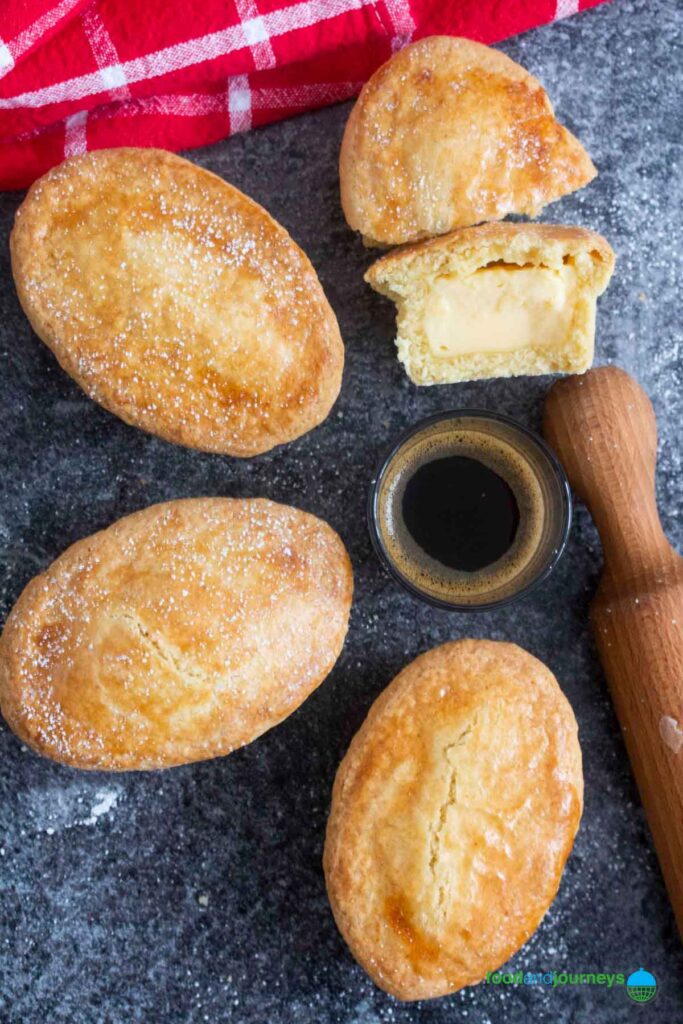
5) Pasticciotto
Pasticciotto is a popular Italian pastry filled with creamy custard. It originated in Lecce, a city in the south of Italy.
You start by making a dough called pasta frolla. This dough is made from flour, sugar, eggs, and butter. Once the dough is ready, let it rest in the fridge.
Next, roll out the dough and line small molds with it. Fill each mold with pastry cream, leaving a bit of space at the top.
After filling the molds, cover the tops with more dough. Brush the tops with an egg yolk and milk mixture. Bake the pastries in the oven at 350°F for about 30 minutes.
The pastries should be golden brown when done. Let them cool before eating. Sprinkle powdered sugar on top for extra sweetness. Enjoy your delicious homemade pasticciotto!
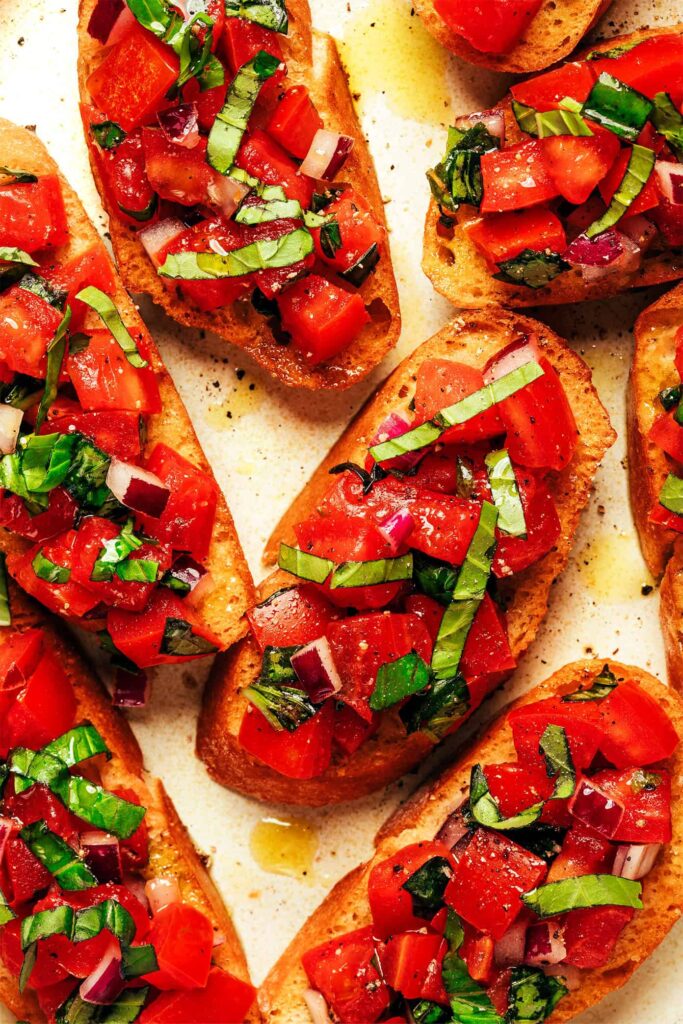
6) Bruschetta
Bruschetta is a classic Italian breakfast dish that’s both simple and delicious. It typically starts with a base of toasted bread, which is often a baguette sliced into 1/4 to 1/2 inch pieces.
You’ll want to rub each slice with a garlic clove to give it that extra flavor.
After that, drizzle both sides of the bread with a bit of olive oil. You can toast the bread either on a grill or in a hot skillet until it’s nicely browned on both sides.
The topping often consists of diced Roma tomatoes mixed with red onion, fresh basil, and chopped garlic.
Add a splash of red wine vinegar and some more olive oil to the mixture.
Combine everything well to let the flavors meld together.
Serve the tomato mixture on the toasted bread.
Bruschetta is popular because it’s both easy and versatile. You can experiment with different toppings. Try roasted tomatoes with sea salt and pepper for a twist.
For a heartier version, you might include toppings like mozzarella, prosciutto, or even a poached egg.
This makes Bruschetta a perfect dish to customize for your morning preferences.

7) Sfogliatella
Sfogliatella is a popular Italian pastry that you can enjoy for breakfast. Originating from Naples, this treat is known for its crisp, thin layers and rich filling.
To make Sfogliatella, you start by preparing a dough. You will knead the dough until it is smooth. Then, wrap it in plastic and refrigerate it for 30 minutes.
Next, roll out the dough and spread a thin layer of lard over it. This step is crucial to getting those signature flaky layers.
The filling, a thick and smooth cream, is made by whisking semolina flour with milk and sugar. After the cream thickens, it’s cooled and then chilled in the fridge.
Once the dough and filling are ready, you shape the pastry. Place the filling inside and fold the dough to create a shell-like appearance. The pastries are then baked at 400°F (200°C) until golden brown. This usually takes about 20-25 minutes.
Sfogliatella is best enjoyed fresh from the oven. It offers a delightful crunch with every bite, paired with the creamy and sweet filling inside. This makes for a truly satisfying breakfast experience.
You can often find Sfogliatella in Italian bakeries, but it’s also rewarding to try making it yourself at home.

8) Biscotti
Biscotti, also known as cantucci, are classic Italian biscuits that are often enjoyed as part of breakfast. These crunchy treats are typically almond-flavored, but variations include chocolate, pistachio, and hazelnut. They are baked twice, which gives them their signature crispiness.
You might find biscotti served alongside a cup of strong espresso or cappuccino. Dipping biscotti into coffee softens them slightly, making them easier to eat and enhancing their flavor. This makes it a popular morning pairing in Italy.
In recent years, biscotti have gained popularity beyond Italy. They are now a common choice for breakfast or a snack in many countries. Their long shelf life and versatility in flavors make them a convenient and tasty option.
To make biscotti at home, you can start by mixing flour, sugar, eggs, and your choice of nuts or flavorings. Form the dough into a log, bake it until firm, then slice it into thin pieces. Finally, bake the slices again until they are golden and crisp.
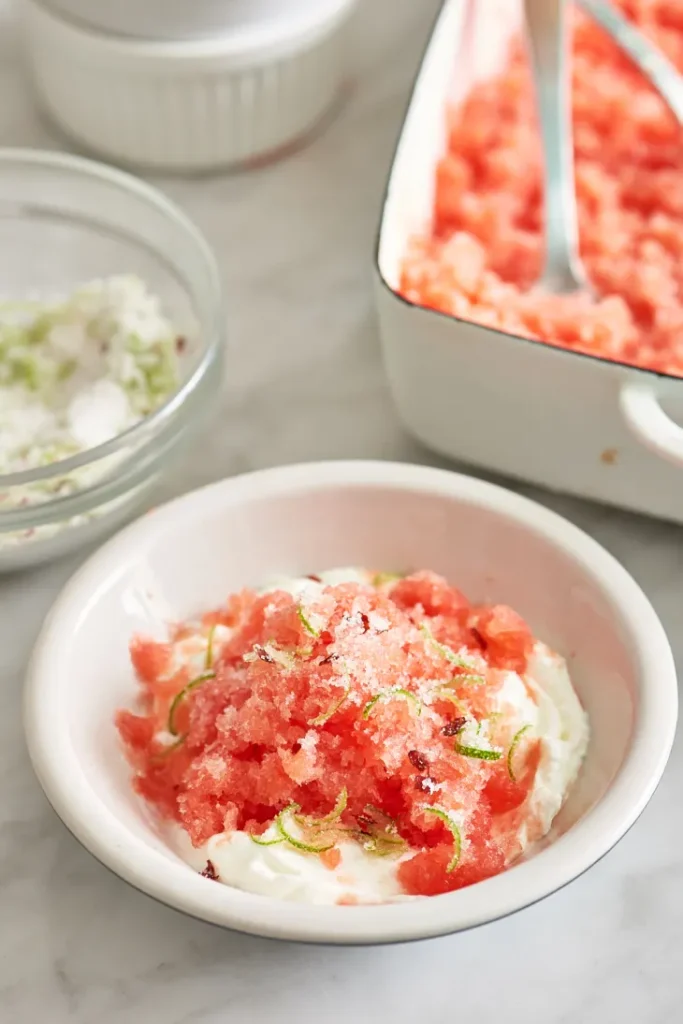
9) Granita
Granita is a traditional Italian treat, especially popular in Sicily. Made from water, sugar, and various flavorings, it is a semi-frozen dessert similar to sorbet. The texture can be coarse or fine, depending on how it is made.
Flavors of granita range from fruity options like lemon, strawberry, and almond to more unusual choices like coffee and chocolate. The fresh ingredients make it refreshing and perfect for hot summer days.
You will often find granita served with a Sicilian brioscia. This special brioche is soft, sweet, and flavored with vanilla or citrus. Together, granita and brioscia make a delightful breakfast pairing.
For a basic granita, you mix the ingredients and freeze them. Stirring every 30 minutes as it freezes helps create the right texture. This makes your granita fluffy and icy without becoming a solid block.
Granita is not just a breakfast item. It can also be enjoyed as a snack or dessert throughout the day. It is a versatile and delicious way to start or end your day in Italy.
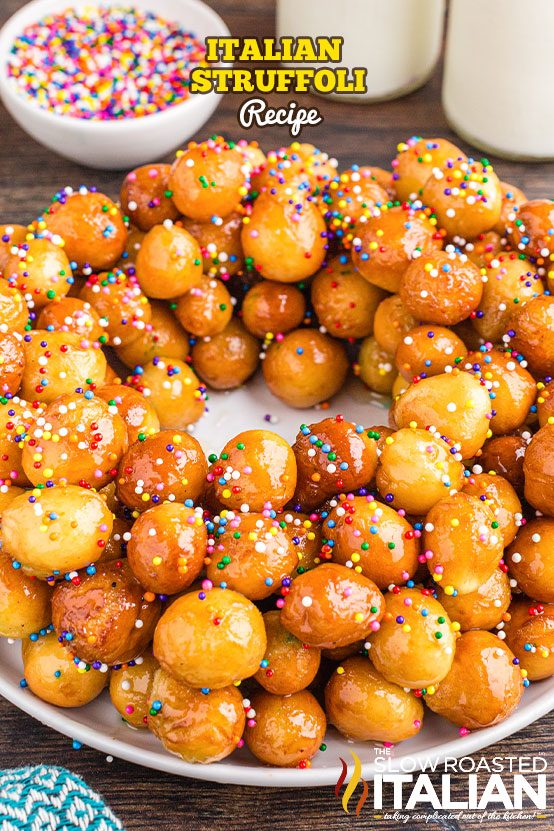
10) Struffoli
Struffoli are small, deep-fried dough balls coated in honey. They are traditionally served as a festive treat, especially during the holiday season in Southern Italy.
To make Struffoli, you start by mixing flour, baking powder, salt, and sugar. Then, you add melted butter, eggs, and sometimes a splash of liquor like Grand Marnier or orange juice.
After forming the dough, you roll it into small balls, about the size of marbles. These dough balls are then fried until they turn golden brown.
Once the Struffoli are fried, they are coated with warm honey, making them sweet and sticky. You might also add orange zest or other flavorings for extra taste.
Struffoli are typically piled into a mound and often decorated with colorful sprinkles or candied fruit. They are not just a treat but a beautiful addition to your breakfast table.
Despite being a bit messy, Struffoli are a delightful and sweet way to start the day. They offer a taste of Italian tradition and are sure to be a hit with anyone who tries them.

11) Ricotta Pancakes
Ricotta pancakes are a delightful twist on the classic breakfast favorite. They are fluffy and moist, made with ricotta cheese, which adds a creamy texture and a hint of richness.
To make these pancakes, start by combining ricotta with wet ingredients in a small bowl. In a separate bowl, mix the dry ingredients.
Next, combine the wet and dry ingredients, mixing until just blended. This helps keep the pancakes light and airy.
Heat a griddle or skillet over medium-high heat and grease it lightly. Use a 1/3-cup measure to pour the batter onto the hot surface.
Cook the pancakes until the underside is golden brown, about 2 minutes. Then, flip them and cook the other side until light brown.
Once cooked,
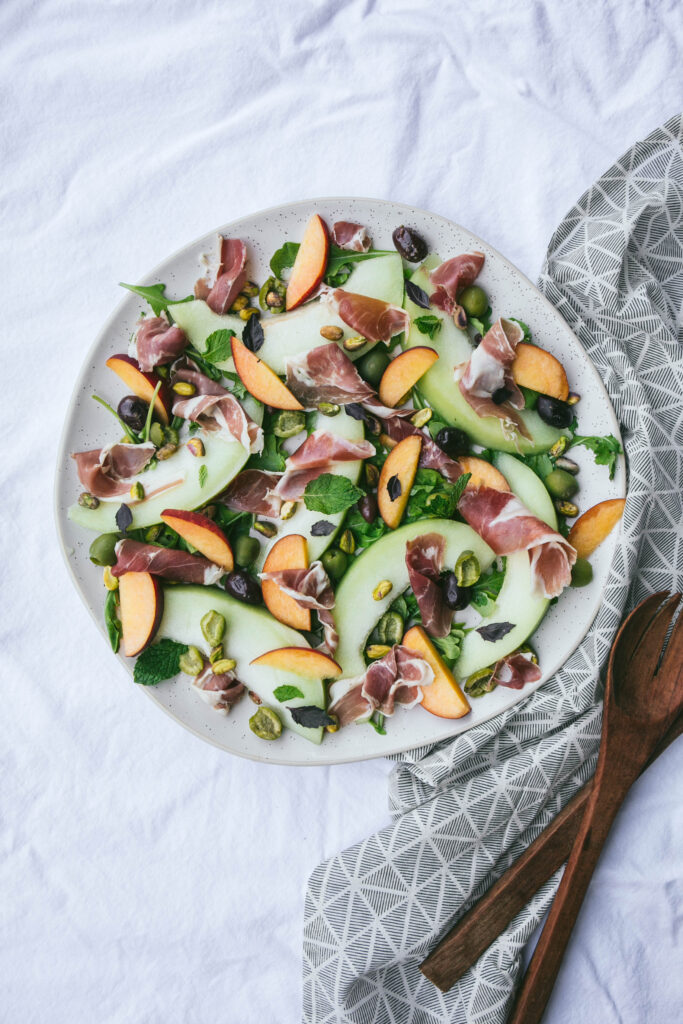
12) Prosciutto and Melon
Prosciutto and melon, or “Prosciutto e Melone,” is a simple yet elegant Italian breakfast dish. It combines the sweetness of ripe melon with the savory, salty flavor of thinly sliced prosciutto. This dish is perfect for summer mornings.
To prepare, start by slicing a melon, usually cantaloupe or honeydew, into evenly sized wedges or cubes. Remove any seeds and peel if desired.
Next, carefully wrap each piece of melon with a slice of prosciutto. You can use a full slice or half, depending on the size of the melon piece. This combination offers a refreshing and satisfying bite.
Serve the prosciutto-wrapped melon on a platter. It makes a lovely addition to any breakfast spread or can be enjoyed on its own. The contrast of flavors and textures makes it a favorite for many.

13) Arancini
Arancini are a popular Italian snack made from leftover risotto. These fried rice balls have a crispy exterior and a soft interior. They are traditionally filled with a variety of ingredients like cheese, meat sauce, or vegetables.
To make arancini, begin by cooking the rice with chicken stock until it’s fully absorbed. Let the rice cool before mixing in grated cheese and beaten eggs. Shape the mixture into small balls using your hands.
Common fillings include mozzarella or caciocavallo cheese along with meat sauce. Once filled, roll the rice balls in breadcrumbs to coat. You can either deep-fry or bake them until golden brown.
For a healthier option, try cooking arancini in an air fryer. Preheat the air fryer to around 375°F, and cook the breaded rice balls for 12-15 minutes, turning them occasionally. This method uses less oil and still achieves a crispy texture.
Arancini are a versatile food, perfect for breakfast, lunch, or a snack. Serve them hot with marinara sauce on the side for dipping. Enjoy the blend of crispy and creamy textures that make arancini a delightful addition to your Italian breakfast menu.

14) Focaccia
Focaccia is a type of flatbread that is popular in Italy. This bread is known for its rich and chewy texture. It often has a crispy crust on the outside.
To make focaccia, you start by mixing flour, yeast, olive oil, and water. After kneading the dough, you let it rise. This step helps make the bread light and airy.
Once the dough has risen, you press it into a baking pan. You then sprinkle it with toppings like rosemary, garlic, or sea salt. Some recipes suggest adding onions for an extra burst of flavor.
Focaccia can be served in many ways. You might enjoy it as a side dish with salads or soups. It’s also perfect for making sandwiches. You can even top it with eggs to create a hearty breakfast dish.
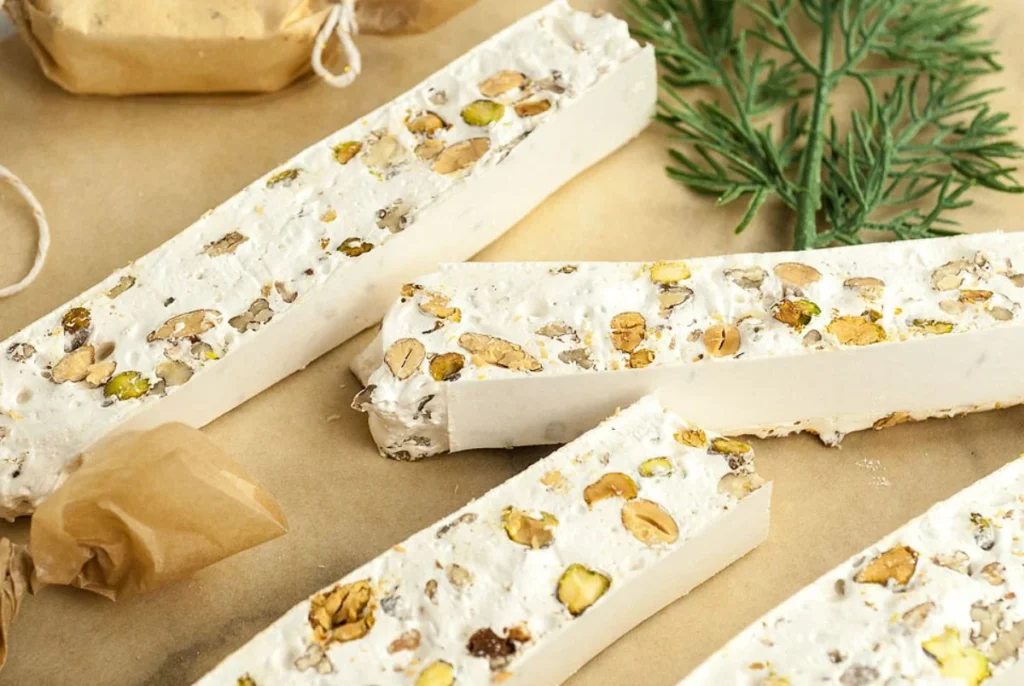
15) Torrone
Torrone is a traditional Italian nougat candy often enjoyed around the holidays, but it can also be a delightful breakfast treat. This sweet is made from honey, sugar, and egg whites, mixed with nuts like almonds, pistachios, or hazelnuts.
First, honey is heated for about 1.5 to 2 hours to caramelize it. Egg whites are then whisked until they form stiff peaks. These two mixtures are then combined and cooked over low heat until the mixture becomes thick and white.
The mixture is then spread between two sheets of edible rice paper and left to cool for several hours. The rice paper helps to keep the nougat from sticking and gives it a unique texture.
You can also toast nuts to enhance their flavor before mixing them into the candy. Serve torrone in small pieces for a sweet start to your day.
Historical Background of Italian Breakfast Foods
Italian breakfast foods have deep-rooted histories shaped by regional culinary traditions and the nation’s evolving dietary habits.
Origins and Evolution
Many Italian breakfast items have their origins in ancient Roman times. Romans often started their day with pane fecit, a type of flatbread. Over centuries, this transformed into various types of breakfast bread still enjoyed today.
During the Middle Ages, simplicity was key due to scarce resources. Bread and cheese became common morning fare. The introduction of coffee in the 1600s also changed breakfast, making a quick espresso a staple for many Italians.
Influence of Regions on Breakfast Traditions
Italy’s diverse regions each have unique breakfast foods. In the north, you might find brioche and coffee. Southern Italy favors lighter options such as fette biscottate with jam.
Venice is known for its frittelle during Carnival, while Naples has introduced the world to its famous sfogliatelle. These regional differences highlight the variety in Italy’s breakfast culture.
Nutritional Value and Health Benefits
Italian breakfast foods often combine simple, fresh ingredients that provide essential nutrients and support a balanced diet. You’ll find recipes rich in vitamins, proteins, and healthy fats, beneficial for starting your day right.
Common Ingredients and Their Benefits
Bread and Cheese: Italian breakfasts often feature bread paired with cheeses like parmesan, ricotta, or mascarpone. Ricotta cheese is high in protein and calcium, essential for muscle and bone health. Parmesan cheese offers a good source of vitamins and minerals, including phosphorus and selenium.
Fruits and Yogurt: Fresh fruits like berries and oranges, combined with yogurt, provide a healthy dose of vitamins C and K, which support immune function and blood health. Yogurt also offers probiotics, which are beneficial for digestive health.
Olive Oil: Sometimes included in savory dishes like frittatas, olive oil is rich in healthy monounsaturated fats and antioxidants. It’s known to support heart health by reducing inflammation and improving cholesterol levels.
How Italian Breakfast Foods Support a Balanced Diet
Variety: Italian breakfast offers a balance of carbohydrates, proteins, and fats. This combination aids in sustained energy release. Bread and cereals provide carbohydrates, yogurt and cheeses offer proteins, while olive oil and nuts supply healthy fats.
Portion Control: Many traditional Italian breakfasts are served in moderate portions. This helps in maintaining a balanced intake of calories without overindulgence. Smaller portions also help in better digestion and metabolism.
Nutrient Density: Foods like frittatas, which include vegetables, cheese, and eggs, are nutrient-dense. They provide most of your daily nutritional needs in a single dish. These ingredients offer a wide range of vitamins, minerals, antioxidants, and healthy fats.
Low-Glycemic Options: The inclusion of nuts, whole grains, and low-sugar fruits helps to stabilize blood glucose levels. This can be especially beneficial for maintaining energy levels and preventing energy crashes throughout the day.
Cultural Significance
Italian breakfast foods represent more than just a morning meal. They convey the essence of Italian daily life and highlight special celebratory traditions through unique culinary practices.
Role in Daily Life
In Italy, breakfast is typically a lighter affair compared to other meals. This tradition stems from a cultural focus on beginning the day with simplicity. Common items include pastries, bread, and coffee, often enjoyed at local cafes. These morning routines emphasize social connections as Italians frequently gather to chat and share a quick bite.
Fette Biscottate, a type of toasted bread, is often paired with fruits or spreads such as jam and honey. This reflects the Italian preference for a quick yet enjoyable meal that does not compromise on flavor. Additionally, the choice of lighter items like cornetti (Italian croissants) aligns with the leisurely pace typical of Italian mornings.
Celebratory Breakfast Foods
Certain breakfast foods in Italy hold special cultural significance during holidays and regional festivals. For example, during Carnival season, Italians enjoy Frittelle, deep-fried doughnuts that symbolize festivity and indulgence.
Other special items like Ciambella (Italian doughnuts) are often present during family celebrations. These foods are not just delicious but also deeply rooted in the cultural fabric of Italian society. Regional variations highlight Italy’s diverse culinary history, making each specialty a testament to local traditions and flavors.
The integration of specific foods during celebrations underlines the importance of breakfast as a symbolic start to special days and events, showcasing Italy’s rich culinary heritage.
